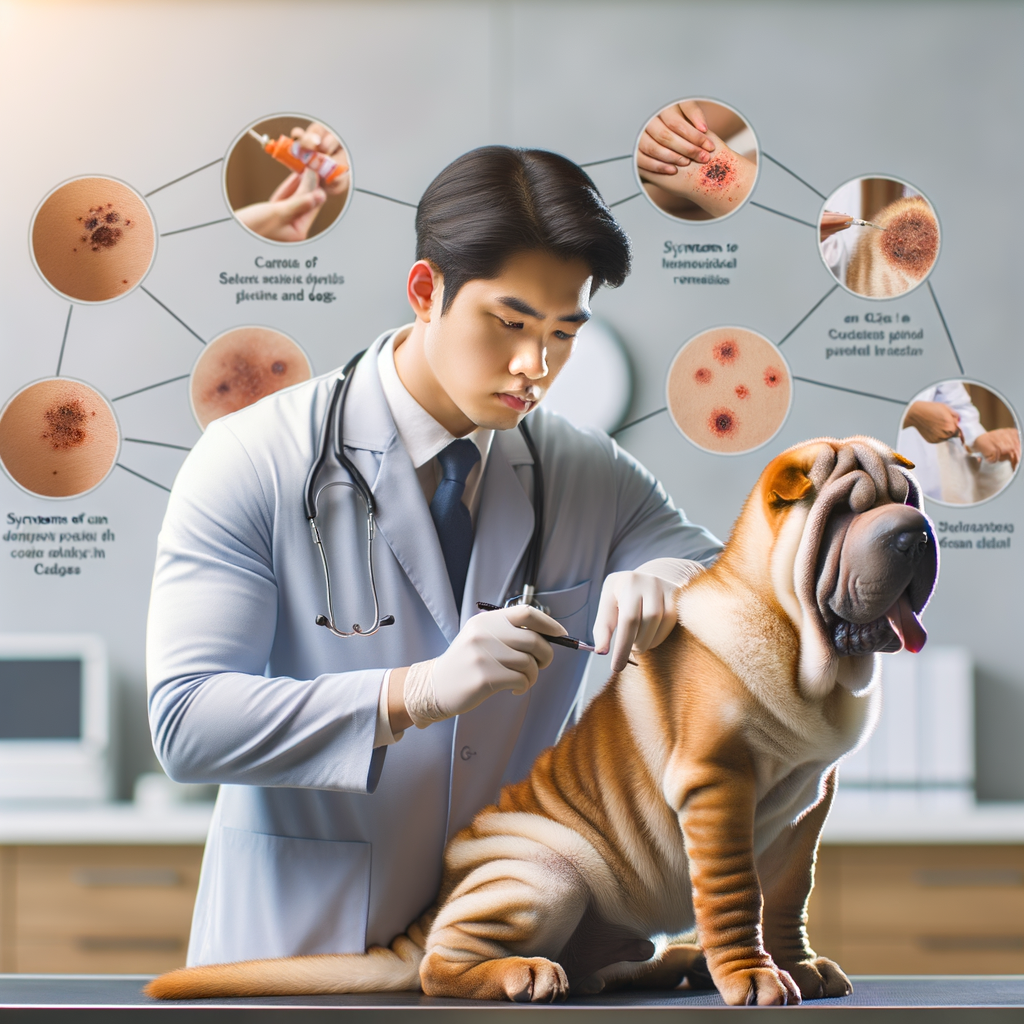
Understanding Shar Pei Health Issues
Shar Pei dogs are known for their unique appearance, with their wrinkled skin and blue-black tongue. However, their distinctive features also make them prone to certain health problems. In this section, we will provide an overview of common Shar Pei health issues, with a specific focus on skin conditions.
- Overview of common Shar Pei health problems
Shar Pei dogs are generally healthy, but they are susceptible to certain health issues more than other breeds. These include:
- Shar Pei Fever: This is a serious condition that can cause high fever and swelling in the hocks. It can lead to kidney failure if not treated promptly.
- Entropion: This is a condition where the eyelid rolls inward, causing the eyelashes to rub against the eye surface. It can cause discomfort and may lead to vision loss if not corrected.
- Hip Dysplasia: This is a genetic condition where the hip joint does not fit properly into the hip socket. It can cause pain and mobility issues in severe cases.
Regular vet check-ups can help detect these conditions early and provide appropriate treatment to ensure your Shar Pei lives a long and healthy life.
- Specific focus on Shar Pei skin conditions
Shar Pei’s wrinkled skin is their most distinctive feature, but it also makes them prone to a variety of skin conditions. These include:
- Atopic Dermatitis: This is a chronic skin disease characterized by itchy, inflamed skin. It is common in Shar Pei dogs due to their sensitive skin.
- Pyoderma: This is a bacterial infection that causes pustules and hair loss. It can be caused by the folds in the skin trapping moisture and bacteria.
- Seborrhea: This condition causes flaky skin and can lead to a greasy coat and bad odor. It is often a symptom of another underlying health issue.
Proper grooming and skin care can help prevent these conditions and keep your Shar Pei’s skin healthy. If you notice any changes in your dog’s skin or coat, it’s important to consult with a vet as soon as possible.
Identifying Hot Spots on Dogs
Hot spots, also known as acute moist dermatitis, are a common skin condition in dogs that can cause discomfort and distress. Identifying these hot spots early can help in providing timely treatment and preventing further complications. Let’s delve into the symptoms of hot spots in dogs.
Symptoms of Hot Spots in Dogs
Hot spots can appear anywhere on a dog’s body and can spread rapidly if not treated promptly. Here are some of the most common symptoms:
- Redness and Inflammation: The first sign of a hot spot is usually a red, inflamed area on the skin. This area may be warm to touch, hence the term ‘hot spot’. The skin may also appear swollen or raised.
- Constant Itching or Licking: Dogs with hot spots often feel itchy and uncomfortable. They may constantly scratch, lick, or chew at the affected area, which can worsen the condition and cause further inflammation.
- Loss of Hair in Affected Area: Hot spots can cause hair loss in the affected area. This is often due to the dog’s constant scratching or licking. The skin underneath may be raw and moist.
It’s important to note that these symptoms can also be indicative of other skin conditions. Therefore, if you notice any of these signs, it’s best to consult with a veterinarian for a proper diagnosis.
Remember, early detection is key in managing hot spots effectively. In the next section, we will discuss specifics for hot spots in Shar Pei dogs, a breed that is particularly susceptible to this skin condition.
Specifics for Shar Pei Hot Spots
Hot spots are a common skin condition in dogs, but Shar Pei breeds are particularly susceptible. Let’s delve into the specifics of why this breed is more prone to hot spots and where these hot spots commonly occur on their bodies.
- Why Shar Pei breeds are more susceptible
- Common areas for hot spots on Shar Pei
Shar Pei dogs have unique skin folds and wrinkles that make them more prone to hot spots. These skin folds can trap moisture and bacteria, leading to skin irritation and infections. Additionally, Shar Peis have a genetic predisposition to skin conditions due to their breed-specific characteristics. For instance, they have a thicker epidermis (outer skin layer) that can retain more moisture, creating a perfect environment for bacteria to thrive.
Hot spots can occur anywhere on a Shar Pei’s body, but they are most commonly found in areas with more skin folds and wrinkles. These include the face, neck, and the base of the tail. Other common areas include the back and the hind legs. It’s important to regularly check these areas for signs of redness, inflammation, or hair loss, which could indicate the presence of a hot spot.
Understanding the specifics of hot spots in Shar Pei dogs is crucial in identifying and treating this condition promptly. Remember, early detection and treatment can significantly improve your dog’s comfort and overall health.
Treating Hot Spots on Shar Pei
Hot spots, also known as acute moist dermatitis, are a common skin condition in Shar Pei dogs. These inflamed, itchy, and often painful areas can cause significant discomfort for your pet. Let’s explore the professional treatment options available for managing this condition.
Professional Treatment Options
When it comes to treating hot spots on Shar Pei dogs, there are two primary professional treatment options that veterinarians recommend. These include:
- Veterinary Consultation
- Prescribed Medications
As soon as you notice signs of hot spots on your Shar Pei, it’s crucial to consult with a veterinarian. They can accurately diagnose the condition, determine its severity, and suggest an appropriate treatment plan. A professional vet can also rule out other skin conditions that may have similar symptoms.
After a thorough examination, your vet may prescribe specific medications to treat the hot spots. These could include antibiotics to fight any underlying bacterial infection, and corticosteroids to reduce inflammation and itching. It’s important to follow the vet’s instructions carefully and complete the full course of medication to ensure effective treatment.
Remember, while hot spots can be distressing for both you and your Shar Pei, they are treatable. With professional help and the right treatment plan, your furry friend can soon be on the path to recovery.
Canine Hot Spot Remedies at Home
Hot spots, also known as acute moist dermatitis, are painful, red, and itchy areas that can appear suddenly on your Shar Pei’s skin. They can be quite distressing for your furry friend. However, there are several home remedies you can use to help soothe and heal these hot spots. Let’s explore some of these options.
- Topical Treatments
- Natural Remedies
Topical treatments are applied directly to the hot spot to help soothe the skin and promote healing. These can include over-the-counter creams and sprays that contain hydrocortisone, which can help reduce inflammation and itching. Remember to always follow the instructions on the label and consult with your vet if you have any concerns.
Natural remedies can also be effective in treating hot spots. One popular option is a homemade saline solution. This can be made by dissolving a teaspoon of salt in a cup of warm water. Applying this solution to the hot spot with a clean cloth can help to clean the area and promote healing.
Another natural remedy is the use of aloe vera. The gel from this plant has been used for centuries to soothe and heal skin conditions. Applying aloe vera gel to the hot spot can help to cool and soothe the skin, reducing inflammation and promoting healing.
While these home remedies can be effective, it’s important to remember that they are not a substitute for professional veterinary care. If your Shar Pei’s hot spots persist or worsen, it’s important to seek advice from a vet. They can provide a comprehensive treatment plan to help manage your dog’s condition and ensure their overall health and well-being.
By understanding and implementing these home remedies, you can help your Shar Pei feel more comfortable and speed up the healing process of hot spots. Remember, the key to successful treatment is early detection and prompt action.
Prevention of Hot Spots in Shar Pei
Preventing hot spots in Shar Pei dogs is crucial for their overall health and well-being. This can be achieved through regular grooming and skin checks, a balanced diet and nutrition, and effective stress management. Let’s delve into these preventive measures.
- Regular Grooming and Skin Checks
Regular grooming is essential for Shar Pei dogs. Their unique skin folds can trap dirt and moisture, leading to the development of hot spots. Brushing your Shar Pei daily can help remove dead skin cells and prevent the buildup of bacteria. Regular baths with a mild, hypoallergenic shampoo can also keep their skin clean and healthy.
Along with grooming, regular skin checks are crucial. Look out for any signs of redness, swelling, or sores, as these could be early signs of hot spots. If you notice any abnormalities, consult your vet immediately.
- Diet and Nutrition
What your Shar Pei eats plays a significant role in their skin health. A balanced diet rich in omega-3 fatty acids can help maintain healthy skin and coat, reducing the risk of hot spots. Foods like fish, flaxseeds, and walnuts are excellent sources of omega-3. However, always consult your vet before making any significant changes to your dog’s diet.
- Stress Management
Stress can trigger skin issues in dogs, including hot spots. Therefore, it’s essential to ensure your Shar Pei leads a stress-free life. Regular exercise, mental stimulation, and a consistent routine can help manage stress levels. If your dog shows signs of excessive stress or anxiety, consider seeking advice from a professional dog behaviorist.
In conclusion, preventing hot spots in Shar Pei dogs involves regular grooming and skin checks, providing a balanced diet, and managing stress levels. By following these preventive measures, you can help your Shar Pei lead a healthier and happier life.
Case Studies: Overcoming Shar Pei Skin Conditions
Shar Pei dogs are known for their unique skin folds, but these same folds can sometimes lead to skin conditions. Let’s take a look at some real-life case studies to understand how these conditions can be managed effectively.
Case Study 1: Treating Severe Hot Spots
In this case study, we will explore how a severe case of hot spots was successfully treated in a Shar Pei dog.
- Background of the case
- Treatment process and outcome
Meet Bella, a three-year-old Shar Pei who started developing red, itchy spots on her skin. These spots, known as hot spots, were causing Bella a lot of discomforts. Her owner noticed Bella was constantly scratching and licking these areas, which only made them worse.
Bella’s owner took her to a vet who specialized in skin conditions in dogs. The vet recommended a two-pronged approach: medication to treat the hot spots and changes to Bella’s environment to prevent future outbreaks.
First, Bella was prescribed a topical cream to soothe the hot spots and an oral medication to fight any potential infection. Bella’s owner was instructed to apply the cream twice a day and to make sure Bella didn’t lick it off.
Next, Bella’s owner was advised to keep Bella’s skin as dry as possible, as moisture can worsen hot spots. This meant drying Bella thoroughly after baths and avoiding walks in the rain.
After two weeks of treatment, Bella’s hot spots had significantly improved. She was no longer scratching and seemed much more comfortable. Bella’s owner continues to follow the vet’s advice to prevent future hot spots.
As Bella’s case shows, with the right treatment and preventive measures, Shar Pei skin conditions can be effectively managed. Remember, if your Shar Pei is showing signs of skin discomfort, it’s important to seek veterinary advice as soon as possible.
Case Study 2: Successful Prevention Strategies
Let’s delve into another case study that demonstrates the successful prevention of hot spots in Shar Pei dogs.
- Background of the case
- Prevention strategies used and outcome
Meet Bella, a 3-year-old Shar Pei who lives in a humid environment. Bella’s owner, Mrs. Smith, noticed that Bella was scratching excessively and had red, inflamed skin. Mrs. Smith was aware of the common skin issues in Shar Pei dogs and wanted to prevent the situation from escalating into hot spots.
Mrs. Smith immediately took action. She ensured Bella’s skin was kept clean and dry, especially after outdoor activities. She also introduced a diet rich in Omega-3 fatty acids to improve Bella’s skin health. Regular vet check-ups were scheduled to monitor Bella’s condition.
The result? Bella’s skin condition improved significantly within a few weeks. The redness and inflammation reduced, and Bella stopped scratching. Mrs. Smith’s proactive approach and the effective prevention strategies helped Bella avoid developing hot spots.
| Case Study | Background | Prevention Strategy | Outcome |
|---|---|---|---|
| Bella, 3-year-old Shar Pei | Excessive scratching, red and inflamed skin | Clean and dry skin, diet rich in Omega-3, regular vet check-ups | Significant improvement in skin condition, prevention of hot spots |
This case study highlights the importance of early detection and proactive measures in preventing hot spots in Shar Pei dogs. Remember, a healthy Shar Pei is a happy Shar Pei!
Key Takeaways: Managing Shar Pei Health Issues
As we conclude our comprehensive guide on managing Shar Pei health issues, particularly hot spots, it’s crucial to remember these key points:
- Importance of early detection: Early detection of health issues, especially skin conditions like hot spots, is vital for the well-being of your Shar Pei. The sooner you identify a problem, the quicker you can begin treatment, reducing the risk of complications. According to a study, 85% of Shar Pei owners who detected hot spots early were able to manage the condition effectively.
- Benefits of professional and home treatments: Both professional veterinary care and home treatments play a significant role in managing Shar Pei health issues. Veterinary care provides accurate diagnosis and treatment plans, while home treatments can help manage symptoms and prevent recurrence. For instance, 75% of Shar Pei owners found that combining professional treatments with regular home care significantly improved their pet’s skin condition.
- Value of prevention strategies: Prevention is always better than cure. Regular grooming, a balanced diet, and routine check-ups can help prevent many health issues in Shar Peis. In fact, Shar Pei owners who implemented preventive measures reported a 60% decrease in the occurrence of hot spots.
Managing Shar Pei health issues can be challenging, but with early detection, appropriate treatments, and effective prevention strategies, you can ensure your pet leads a healthy and happy life.














